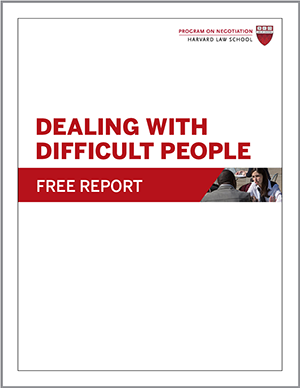
What’s the best way for members of a group to reach a decision jointly? Majority rule, or an up-or-down vote, is one commonly used method. But voting can lead to unstable decisions, as those in the minority may fail to back the final outcome or even try to sabotage it. By comparison, a process known as consensus building tends to lead to more stable, lasting decisions. You may be able to help improve group negotiation and decision making in your organization by adopting consensus-building techniques.
What Is Consensus Building?
In consensus building, group members commit to “seek overwhelming agreement among all relevant stakeholders,” writes Lawrence Susskind in his book Good for You, Great for Me: Finding the Trading Zone and Winning at Win-Win Negotiation. “The result is a negotiated decision that is as close to unanimous as possible. From an organizational standpoint, consensus-building techniques help groups as a whole win . . . to reach the broadest agreement possible, not just one that is barely acceptable to a majority.” By giving all parties a voice, consensus-building techniques tend to produce better long-term results than majority rule, according to Susskind.
Useful Consensus-Building Techniques
In their book The Consensus Building Handbook: A Comprehensive Guide to Reaching Agreement, Lawrence Susskind, Sarah McKearnan, and Jennifer Thomas-Larmer explain the benefits and best practices of consensus building. They also describe key consensus-building techniques. In particular, the authors discuss three common consensus-building approaches, which we summarize here.
1. A Conventional Problem-Solving Approach
In this common consensus-building approach, participants begin by working together to clarify and agree on a definition of the problem to be solved, perhaps with the aid of a neutral facilitator. Next, they discuss and decide on the procedures they will use to conduct their deliberations over possible solutions.
During the education phase that follows, participants share information about the context of the problem, articulate the issues and interests that are most important to them, and offer relevant technical information, drawing on their own knowledge or that of experts. Next, parties work together to generate possible solutions, then “establish and apply criteria to evaluate the options they have developed,” write the authors.
The next stage is to seek agreement on a package they can all support. Recommendations aimed at meeting everyone’s interests are added to the package of proposals. If someone opposes a proposal, they should be required to suggest ways to make the overall package acceptable to them without worsening it for others. Finally, the parties should set up successful implementation by staying in close contact with other parties after the agreement is reached to ensure it succeeds.
2. Working with a Single-Text Document
The single-text approach to consensus building involves “introducing a working draft of an agreement early in a process for parties to discuss and revise,” according to the authors of The Consensus-Building Handbook. The single text might be developed by a mediator who has gathered the information needed to draft a document by interviewing all parties. Or it could be drafted by someone with technical expertise who has knowledge about the issues and is familiar with participants’ views on those issues. Finally, a subgroup of stakeholders could work together to draft a single-text document.
“The single-text method provides a clear structure for discussions and a focal point for identifying areas of agreement and disagreement,” write Susskind and colleagues. This approach can be particularly useful when technical, regulatory, or statutory language is needed and when a large number of stakeholders are involved.
3. A Visioning Approach
The third and final of the consensus-building techniques involves focusing the attention of participants on the future during the process of identifying options and working toward agreement. A visioning approach typically involves the group asking and answering the following questions:
- “What do we have?” This question offers an opportunity for participants to assess the strengths and weakness of their current situation.
- “What do we want?” This question asks group members to describe an ideal outcome that would meet the underlying interests of the various parties. “Parties in conflict frequently find it easier to think about solutions in the future than in the present,” write the authors. Doing so “frees them up to be more creative.”
- “How do we get there?” During this stage in the consensus-building process, participants put forth possible strategies for implementing their plan, which can be included in the consensus agreement.
While visioning can be useful in most contexts, it can be particularly helpful when parties are entrenched in firm positions, according to Susskind, McKearnan, and Thomas-Larmer. In such situations, they write, “The exercise of thinking about the future can produce more common ground than discussions that remain focused on the present.”
What other consensus-building techniques and approaches have you found to be useful in group negotiation and decision making?





